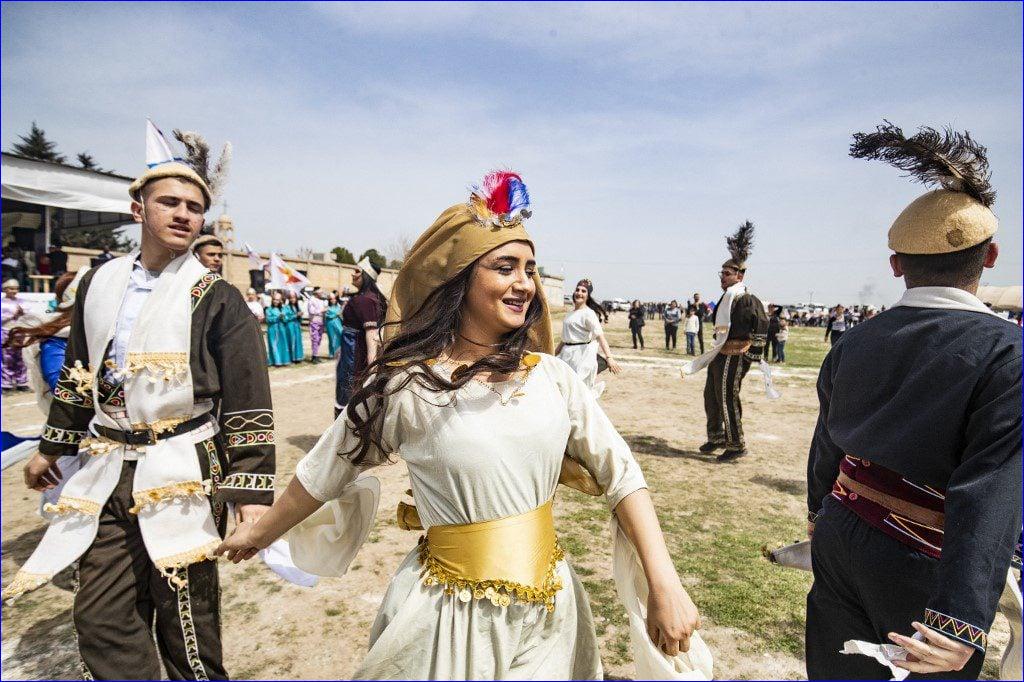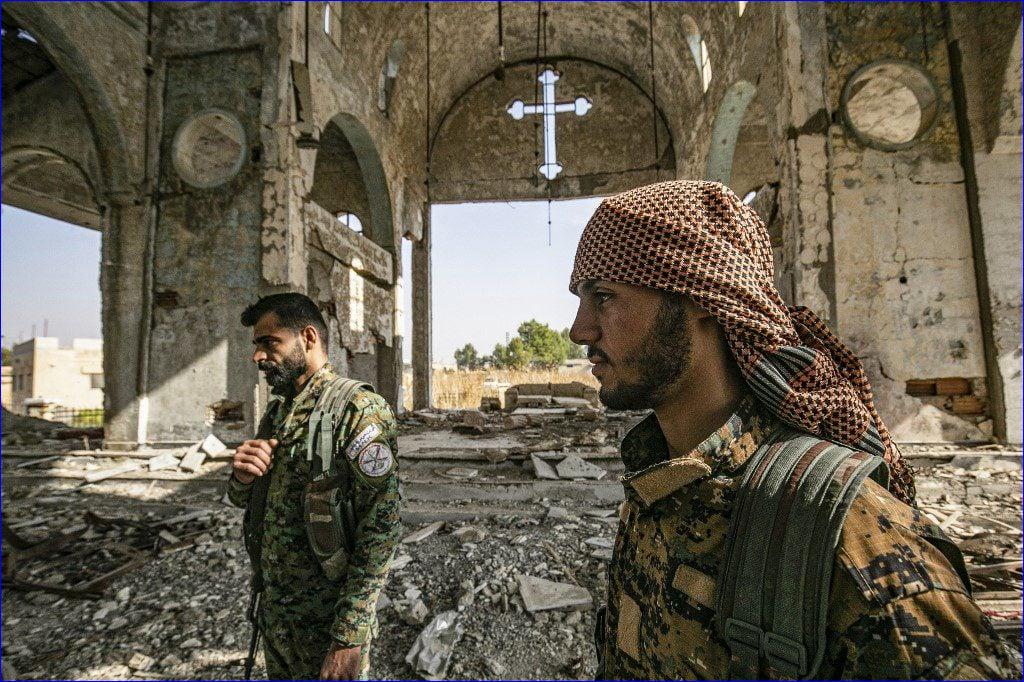


 Delil Souleiman/AFP)
Delil Souleiman/AFP)
Before the Syrian crisis, the Assyrian Policy Institute reported around 300,000 Assyrians in Syria. The majority lived around the Khabur River and the al-Jazira region. Due to the ongoing crisis and conflicts, Christians in northeastern Syria, including Assyrians, faced displacement. Assyrians constituted roughly one-third of Syria's Christian population.
Unofficial local estimates now suggest that there are no more than a thousand Assyrians left in the region. These remaining individuals are primarily in the cities of Qamishli and al-Hasakah and their surrounding countryside.
In the Syrian al-Jazira region, Assyrians coexist with a diverse population of various ethnicities and nationalities. This mix includes Arabs, Kurds, Armenians, Chechens, Turkmen, Yazidis and Circassians.
Origins
The Syriac-Assyrian presence in the Levant and Mesopotamia traces back to the fourth millennium BC. Historians mark the emergence of the Assyrian civilisation between the twenty-second and seventh century BC.
Initially, this civilisation was centred in the city of Assyria from the twenty-second to the fourteenth century BC. During this time, the city occasionally came under the control of neighbouring powers. Notably, Sargon of Akkad subjected Assyria and its people to the rule of the Akkadian Empire. Hammurabi, the founder of the Babylonian Empire, also exerted control.
However, between the thirteenth and seventh centuries BC, the Assyrians established an empire that spanned a vast geographical area, encompassing Mesopotamia, the Levant and Egypt. This period marked the rise of the Assyrian Empire, extending its influence over a significant portion of the ancient world.
The Assyrians were early adopters of Christianity, embracing it between the first and third centuries AD. However, the Assyrians faced significant setbacks in the fourth and fifth centuries AD. During this period, the church experienced divisions, exacerbated by the actions of both the Persians and Byzantines. These divisions served as a pretext for continued persecution of the Assyrians by both powers.
During the Umayyad and Abbasid caliphates, following the Muslim conquest of the Levant, Assyrians played a crucial role in laying the state's foundations and building its civilisation. Notably, Assyrians played a part in shaping government offices and departments. Additionally, they contributed to translating Greek science and philosophy into Arabic.
Related: Timeline of ISIS in Iraq
Related: Attacks on Assyrians in Syria By ISIS and Other Muslim Groups
Numerous Assyrians, including Sarjun ibn Mansur, gained prominence during the Umayyad era. He served as an advisor to several Umayyad caliphs. Assyrians continued to play a significant role in translating various sciences during the Abbasid era. Hunayn ibn Ishaq was a notable figure in charge of the House of Wisdom, also known as the Grand Library of Baghdad. At the time, the House of Wisdom was one of the leading cultural and scientific centres in the Arab and Islamic world.
The modern presence of Assyrians in Syria traces back to the period after the genocide that took place against them between 1914 and 1920, before the collapse of the Ottoman Empire. Following the Seyfo genocide, Assyrians migrated to Syria from Turkish cities like Diyarbakir and the eastern Anatolia region. The French mandate was instrumental in securing stability for the surviving Assyrians in Syria.
Following the establishment of the modern Iraqi state, and particularly after the 1933 Simele massacre committed by the Iraqi army, the number of Assyrian arrivals to Syria increased. The massacre occurred because the Assyrians refused to surrender their weapons to the Iraqi state as they feared a repetition of the massacres inflicted upon them by the Ottomans.
The Assyrians who arrived in Syria during this wave were fleeing for the second time. Previously seeking refuge in Iraq following the Seyfo massacres, they suffered a similar fate during the Simele massacre in Iraq and escaped to Syria.
In 1957, following their settlement in various Syrian cities within the al-Hasakah Governorate, the Assyrians founded their first political party, named the Assyrian Democratic Organization. The establishment of this party occurred a year after the Kurds formed the first political party, known as the Kurdish Democratic Party in Syria.
The founding of the Assyrian Democratic Organization happened against a backdrop of increasing nationalist sentiments among minorities in Syria. Concurrently, the Assyrians began to establish schools, cultural institutions and sports clubs, initially in Qamishli and later in Tal Tamr.

 Delil souleiman/AFP)
Delil souleiman/AFP)
Tal Tamr
Tal Tamr has the highest concentration of Assyrian population in Syria, particularly along the Khabur River basin near its outskirts. The city's diverse population, encompassing Kurds, Arabs and Assyrians, has contributed to its unique position within the Syrian demographic landscape. Positioned on the international road (M4) connecting the Iraqi-Syrian border to the Mediterranean Sea, Tal Tamr is a key junction for several important roads in the Syrian al-Jazira region.
Surrounding the city of Tal Tamr are numerous Assyrian villages along the banks of the Khabur River. There are 33 villages, with Tal Juma being the largest among them.
Other villages include Umm al-Kif, Tal Tawil, al-Safah, al-Arisha, Tal Hormuz, Tal Nasri, Tal Jazira and Qabr Shamiya. These villages, known for their highly fertile lands, are renowned for cultivating wheat, grapes and apples and producing high-quality dairy products. They have consistently been a distinctive feature of the Syrian al-Jazira, with their residents making significant economic and social contributions to Syrian society over the centuries.
In 2010, Tal Tamr had a population of about 10,000 people. Yet, this number significantly increased as tens of thousands of displaced individuals from Aleppo, Homs, Raqqa and Deir ez-Zor sought refuge in the city.
The majority of displaced people had gradually migrated from their villages following the entry of Jabhat al-Nusra into the city of Ras al-Ayn in October 2012. The number also grew after the Islamic State attacked the Assyrian villages around Tal Tamr in February 2015. The influx further surged after the threat from the Islamic State diminished in the surrounding areas, bringing the population to around 50,000 people.
The fact that most displaced Arabs and Kurds continue to reside in the homes and farms of Assyrians who left the country has raised significant worry in the Assyrian community, as was expressed in interviews with Fanack.
Tal Tamr's strategic location and recent demographic significance have led to increased efforts by Syrian and international actors to assert control over the city. Notably, the United States routs its armoured vehicles from the Kurdistan region of Iraq through the city centre to reach the areas of Deir ez-Zor and al-Hasakah. Furthermore, forces aligned with the Syrian regime and Russian military police are stationed in the town. Periodic skirmishes also occur along the frontlines near the city, involving the Syriac Military Council, affiliated with the Syrian Democratic Forces (SDF), and opposition factions aligned with Turkey.
Ancient Cultural Heritage
Assyrian culture shares similarities with other Middle Eastern cultures but also possesses unique characteristics, largely influenced by the predominant Christian faith. Key Christian celebrations, including Christmas and Easter, are of great importance, along with the Feasts of the Ascension and the Cross. Additionally, believers observe two important fasts: the Great Lent and the Fast of Nineveh.
Traditionally, Assyrians communicate using two dialects of the Syriac language: Eastern and Western. The Syriac language remains vibrant and extensively spoken in Syria, particularly in the al-Hasakah and Aleppo governorates. The Eastern dialect is prevalent among members of the Assyrian Church of the East and the Chaldean Church. In contrast, the Western dialect is commonly used by members of the Syriac Orthodox Church and the Syriac Catholic Church.
Numerous Assyrians, whether speakers of the Eastern or Western dialect, have made a mark in music. Notable Eastern Assyrian musicians include Juliana Jendo, Edwar Mousa and George Homeh. On the Western side, prominent figures include Habib Mousa, Elias Karam and Jan Karat. Additionally, two well-known Assyrian composers are Gabriel Asaad and Nouri Iskandar.
Burdened Memory
The 23rd of February 2015 marked a tragic day for Syria's Assyrians, particularly those residing in the southern and western villages around Tal Tamr. The Islamic State seized control of 14 villages, including al-Ghaybish, on the other side of the Khabur River. On this day, the Islamic State kidnapped 220 Assyrians.
It destroyed approximately eight churches in the Khabur Basin, including the eighty-plus-year-old Church of the Virgin Mary in Tal Nasri and the Church of Saint Mar Touma in Umm al-Kif. Over the course of a year, the gradual release of the kidnapped Assyrians was facilitated through the intervention of Mar Aprim Athniel, the bishop of the Assyrian Church of the East in Syria. A ransom of 2.2 billion Syrian pounds (equivalent to $22 million at the time) was paid for their freedom.
Elias A., a resident of Tal Tamr, told Fanack, "The attack resulted in villages being destroyed and deserted, with only a few residents remaining." He added, "Our areas, known for their unique culture, customs, traditions and lush greenery, used to be a tourist destination and a getaway for many people from nearby towns and villages. Today, only a handful of families still reside there, in some no more than three or four families. A sense of desolation persists despite the disappearance of the Islamic State."
Similarly, Youssef B., a worker in one of the remaining churches in the area, told Fanack that he now serves in the church alone, whereas in the past, the number of deacons per prayer used to be no less than five. He added, "I used to have many friends, but many emigrated over the past years. Even after the Islamic State's demise, everyone remains at risk of abduction, robbery and murder, particularly those who are well-off."
During Fanack's visit to the city and its nearby villages, it was evident that they were devoid of young people. The Assyrian presence was limited to women and the elderly.
Uncertain Future
At present, as many have emigrated to Australia and Europe, Christians, particularly the Assyrians, are at risk of disappearing from the Syrian landscape. Gabriel M., a leader in one of the region's Assyrian military groups, told Fanack, "The support of Western countries to the Assyrians was not driven by goodwill. Instead, it aimed to depopulate the region of its Christian elements."
Jamila S. told Fanack that her village, which once had over three thousand inhabitants, now is home to only around 20, mostly elderly, people.
Jamila explained, "Everyone left. Some went to Australia, some to Sweden or the United States. Even the clergy departed." Those who remain in the village depend on support from relatives abroad. Jamila remarked, "Those who remain in the village are elderly individuals living on the financial assistance received from abroad. They are patiently awaiting the return of their children and grandchildren before the end of their lives."
Sarah K. expressed, "Life here has become nearly impossible for young people due to the terrorism that has plagued our regions, leading to the abduction and death of hundreds of youth. So, why would they come back?" She continued, "As you can see, most of us are elderly, with a small percentage of young people. The security conditions are precarious, and I would not recommend those who have travelled to Europe to return."
Even with the return of some immigrants to their homeland and various individual and communal efforts to encourage others to return, Assyrian homes remain largely deserted. The pivotal question is this: Once the crisis subsides, will any of the Christian communities -- Assyrian, Chaldean, Syriac, Armenian or Greek -- be left in the cities and villages of the Eastern Mediterranean?

or register to post a comment.